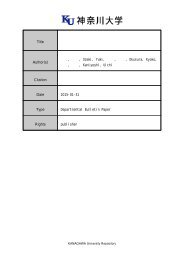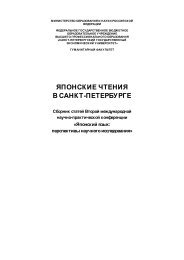to Learners with Special Educational Needs
e-textbook SEN
e-textbook SEN
Create successful ePaper yourself
Turn your PDF publications into a flip-book with our unique Google optimized e-Paper software.
Pokrivčáková, S. et al. (2015). Teaching Foreign Languages <strong>to</strong> <strong>Learners</strong> <strong>with</strong> <strong>Special</strong> <strong>Educational</strong> <strong>Needs</strong>:<br />
e-textbook for foreign language teachers. Nitra: Constantine the Philosopher University. 128 p.<br />
ISBN 978-80-558-0941-0<br />
EFL aims:<br />
Eliciting what the pupils know about the <strong>to</strong>pic – vocabulary specific <strong>to</strong> the <strong>to</strong>pic;<br />
asking questions in present simple about the <strong>to</strong>pic – practicing questions and eliciting what<br />
the pupils are interested in regarded the target <strong>to</strong>pic;<br />
practicing all the four language skills;<br />
practicing present simple tense for present situations and past simple for past situations;<br />
cross-curricular links: learning geographical vocabulary and learning about the map of<br />
Australia.<br />
Drama aims:<br />
Individual and group work in a given situation;<br />
practice the skill of cooperation in groups of different sizes (pairs, small groups, the whole<br />
class as a group);<br />
practice the presentational skills in small groups;<br />
use the found out information in creative work (TPR map, role of the Aboriginal tribes, roles<br />
of the British convicts);<br />
Sources of information:<br />
Simplified reader: Lindop, C. (2008). Australia and New Zealand, Oxford Bookworms, level 3,<br />
Oxford: Oxford University Press.<br />
Encyclopaedias, dictionaries, the Internet.<br />
The methods and conventions: Soundtrack, Circular drama, Defining space, Teacher-in-role,<br />
Meetings in roles, Narration, Note-taking dictation, Text reconstruction, Lying game, Memory<br />
game, Find your pair<br />
The structure of the Lesson:<br />
1. Tune in<br />
First we need <strong>to</strong> tune students in<strong>to</strong> the <strong>to</strong>pic and learn what the pupils already know (the K-<br />
W-L approach – the table can be downloaded from the teaching resources on<br />
www.oup.com/elt/gradedreaders<br />
The teacher asks the students <strong>to</strong> close their eyes, listen carefully and shout any association<br />
that the sounds bring upon their mind. Then the teacher plays the Spirit of Uluru on youtube<br />
(https://www.youtube.com/watch?v=YdZQytU_nS0), waits for the students <strong>to</strong> shout the<br />
associations and writes them on the board in one colour (eliciting what the group knows about<br />
the <strong>to</strong>pic)<br />
2. “Want <strong>to</strong> learn” – the mirror circle (elicitation)<br />
Then the teacher asks the pupils what they want <strong>to</strong> learn about the <strong>to</strong>pic and writes on the<br />
board “I want <strong>to</strong> learn about...”<br />
The pupils have some time <strong>to</strong> think and prepare one sentence each about what they want <strong>to</strong><br />
learn.<br />
Then they form a circle and the teacher tells them that they are his/her mirror and he/she is<br />
thinking about what he/she wants <strong>to</strong> learn. The teacher goes around the circle and the pupils say<br />
what they what <strong>to</strong> learn, e.g. “I want <strong>to</strong> learn about the Aborigines/outback/life in Australia/map<br />
of Australia/Sydney/...”<br />
Then the teacher asks the pupils <strong>to</strong> go <strong>to</strong> the board and write, in different colour, what they<br />
want <strong>to</strong> learn about (they can form interest group that will look information up <strong>to</strong>gether).<br />
3. TPR map of Australia<br />
The teacher asks the pupils <strong>to</strong> create the map of Australia in the classroom using their bodies.<br />
The teacher says, “the north is at the whiteboard, the south is opposite, the west is..” pointing <strong>to</strong><br />
104






